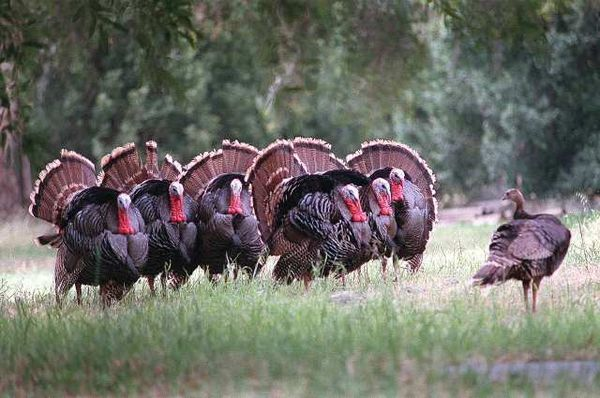By Mike Weilbacher

On Thanksgiving Day, we’ll gather around tables overflowing with food and stuff ourselves silly. And while every family has its own unique take on the traditional meal, in most homes a big turkey anchors the feast, the centerpiece of the table.
While a lot of us might remember that Ben Franklin favored the turkey as the national symbol, what else do we know about turkeys? Not much, right? So here are some turkey facts to gobble up alongside your meal.
In the wild, turkeys are now busily forming winter single-sex flocks, a tom and his brothers joining a fraternal order of other males. During this first winter, the toms spar viciously and violently to establish their pecking order—striking each other with wings, spurred feet and head until exhausted. He who fights longest is the winner, and to him goes the spoils of war: the right to mate in spring.
For when the winter flocks break up, brother turkeys stay together. Finding clearings in forests, they strut their stuff like hyperactive mummers, gobbling loudly, desperately seeking hens. They puff their feathers, fan their tails, drag their wings; on their heads and necks, projections called wattles, snoods and carbuncles variously swell, stand erect and turn bright colors—the better to attract females. THAT’s the turkey our kids draw and we decorate with, by the way, the mature male in full sexual strut.
When the hens arrive, only the strongest brother—top gun—mates. Weaker brothers never mate—never!—but strut every spring in a brotherhood of turkeys that stays together for life, weaker brothers acting as literal wingmen in support of the dominant, he in turn mating with multiple females to spread strong genes throughout the pool.
Despite all that strutting, the wild turkey came thisclose to becoming another passenger pigeon. While turkeys now nest in every Pennsylvania county save Delaware and Philadelphia, turkeys were on the edge of extinction only 40 years ago. Through overhunting and deforestation, 30,000 turkeys strutted in 18 states by 1900; the animal had disappeared completely from all of Canada and New England. While Pennsylvania was the northernmost East Coast state to retain wild turkeys, they had vanished from this corner of the state.
But three things happened that altered its future. Too many hunters let wildlife agencies know that they demanded the bird’s return; wildlife managers learned how to use relict populations in captive breeding programs, re-introducing newly hatched chicks to their former haunts; and in recent decades, forests slowly returned. Creatures of the edge, they crave forests for cover and fields for the seeds and insects they eat. And as their habitat returned, so did they. The National Wild Turkey Federation now estimates some seven million turkeys range across America; Audubon named it one of the “10 Creatures We Saved” in its centennial celebration.
Finally, it is a singular oddity that a North American fowl anchoring a uniquely American holiday is named for a Middle Eastern country. First domesticated by the Aztecs and brought to Spain in the 16th century, the bird found its way to England through Turkey—hence the name.
In fact, everyone around the world seems to name it for an exotic faraway place. The Greeks call it a “French rooster,” while its French nametranslates as “from India.” Bulgarians give it an Arabic word for Egypt, but Arabs dub it the “Roman rooster.” Brazilians inexplicably call it “peru,” a neighboring country with no turkeys. In Pakistan, it is “elephant chicken,” a delightfully evocative name, and the Japanese call it the “seven-faced bird,” a reference to the turkey’s strange face that changes colors and shapes with its mood.
Strangely, only the Russians get it right: their word for turkey means “Native American.”
After your feast, check out the band of brothers watching football, strutting their stuff and fighting for dominance. Some things never change.
Naturalist Mike Weilbacher directs the Schuylkill Center , where turkeys can occasionally be seen. His email is [email protected].
